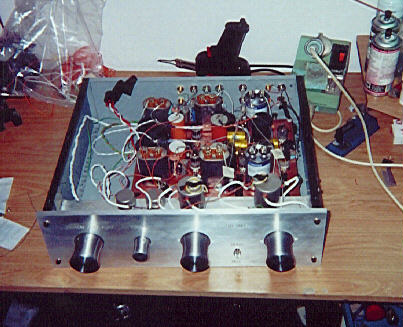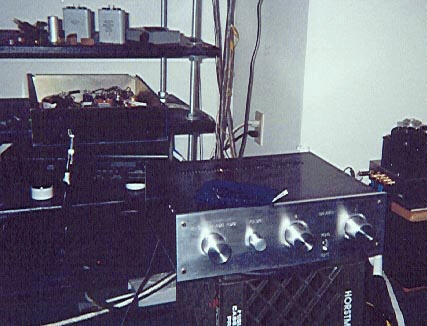A year ago around this time (Feb 2000) I sent the following message to the Joelist:
<<Subject: Rate DIY phono pre's? Date: Fri, 25 Feb 2000
I've been reading a lot on the Phonogram list about the Herron phono pre - it has apparently come to be regarded as the new reference in the eyes of some. Has anyone heard or built a DIY mc phono stage that you feel competes with the recent commercial reference products?>>
The consensus was that it was very possible to build something that not only equaled but surpassed many store-bought hi-end products. Something that I already knew having already built the Randy Fay 5687 preamp and using it in my system for a couple of years. I wanted a full function preamp however, and my build of the Fay circuit had more hum than was desirable. Thorsten, was kind enough to send me the write up and schematic for his Toccata mod of the famous Arthur Loesch preamp. This seemed like a good bet as I already had lots of 5687/6900 and soon found a nice cache of 417A. (BTW, 6900 sounds a little murky in this circuit but with lots of body and great bass. I settled on the 5687. The current regulated heaters make it easy to experiment.)


After some initial hickups with the power supply (I was getting as much as 127 V out of the wall last summer, here in LI, NY.) I had version one built in a couple of months. (Ordering the parts was the hardest part.) Immediately, the battery biased linestage was nothing less than amazing. The Fay preamp has been touted for replacing several big name preamps in some very high end systems and this was/is better in every way. More bass, better defined images and soundstage, blacker space, better tonal balance and to my complete surprise, it was/is totally silent! (I�m not surprised that the design can be silent I was surprised that I could build it to be so.) After implementing better parts and recently x-former volume control (by Sowter) this unit is capable of some very high-end tricks on the right recordings the sound stage extends beyond the side walls and above the ceiling (the above the ceiling thing is a new one on me.) Dynamics and layering are also first class.
Where Thorsten�s work really shines however is in the implementation of the phono eq. I had a well-known hi-end repairman measure the RIAA accuracy. He not only confirmed that the curve was spot on but called it the quietest and most phono eq stable at any volume, phono circuit he had ever measured. If anything, the phono stage is more impressive than the line stage.
Of course, I have a different parts implementation than Thorsten outlines - I have been reading Thorsten and corresponding with him for several years now, and felt that my listening preferences might be better served by a "softer" tone. I did stick as close to Mr T�s layout as possible, however. I used Jensen copper and oils for coupling, mills resistors on the plates and bypassed the Ansar PSU supply caps with oil caps all around. My input resistors at the phono stage are Caddocks which I thought sounded warmer and better balanced than the Rhopoints. For DC blocking I have used a combo of VTV silver/oil, Infinicap and an old 0.22 paper/oil West Cap as a bypass - this is just what I had around in my junk box. I think this unit will probably be even better with a Hovland cap for blocking possibly bypassed with a Rel polystyrene or teflon. I hope this will eliminate a little opaqueness in the upper bass that showed up after installation of the x-former volume controls - which are still breaking in (lots of wire). Thanks again to Thorsten for his saint-like patience in answering all my amateurish questions :)